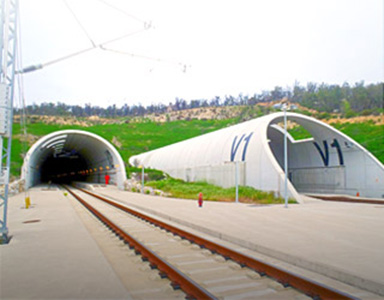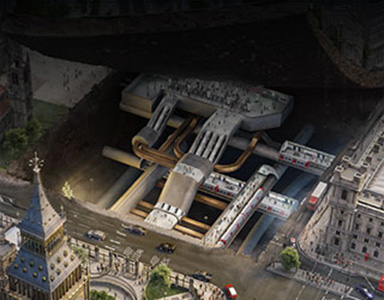Construction Methods
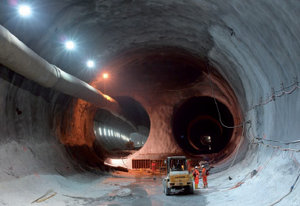
Conventional Tunnelling can be defined as the construction of underground openings of any shape with a cyclic construction process composed of the following steps:
- excavation, by using the drill and blast methods (explosives) or very basic mechanical excavators
- mucking
-
placement of the primary support elements such as:
- steel ribs or lattice girders
- soil or rock bolts
- sprayed or cast in situ concrete

Principles
Conventional Tunnelling is carried out in a cyclic execution process of repeated steps of excavation followed by the application of relevant primary support, both of which depend on existing ground conditions and ground behaviour. An experienced team of tunnel workers (miners), assisted by standard and/or special plant and equipment shall execute each individual cycle of tunnel construction.
The Conventional Tunnelling Method mainly using standard equipment and allowing access to the tunnel excavation face at almost any time is very flexible in situations or areas that require a change in the structural analysis or in the design and as a result of this also require changes in the support measures.
In fact, as opposed to TBM excavation, conventional tunneling allows a very flexible process where the following changes can be easily applied during construction:
- Increase or decrease of support
- Variation of ring closure time (delay between excavation and application of support)
- Introduction of primary support ring closure
- Variation of explosives charge
- Increased or decreased length of excavation
- Splitting of the excavation face according to geological conditions
- Ground treatment according to geological conditions
To know more:
ITA Endorsed paper
Mechanized tunneling
The machines usually found in nowadays tunnels are
Main beam TBMs (or open TBMs)
Shield TBMs
Compressed air
Slurry Shield
EPBS shield
To Know more
Mechanized tunneling (as opposed to conventional techniques) are all the tunneling techniques in which excavation is performed mechanically by means of teeth, picks or disks.
These tunneling techniques comprise then a wide range of different machines, from the simplest like backhoe diggers to the most complicated like confinement-type shield TBMs. These machines not only carry out the excavation of the ground, sometimes they also provide support.
This support can be just peripheral (like in the case of shield TBMs) or also being applied to the front (Earth pressure TBMs or Slurry Shields for instance).
Mucking is also performed automatically by these machines in the majority of cases, as it is the application of permanent support like in the case of shields, where precast concrete elements are placed directly by the machine.
As compared to conventional tunneling, different advantages and drawbacks can be stated for mechanized tunneling:
| Advantages | Drawbacks |
|---|---|
| Enhanced health and safety conditions for the workforce | Lack of flexibility |
| Industrialization of the tunneling process | Difficult adaptation to unexpected geological and hydro-geological conditions |
| Possibility of crossing complex hydro-geological conditions | Not economically optimized for short tunnels |
| Good quality of the finished product | Long time needed for the installation |
Classification of Mechanized Tunnelling Techniques

Surface Tunnelling
Two Main Types of Underground Structures Built by Surface Tunnelling can be identified:
Open Trench
Cut-and-Cover Structures
Surface tunnelling encompasses all construction methods of underground structures built by a temporary or permanent open trench in the surface.
The construction sequence of surface tunneling is composed of the following steps:
- Construction of retaining walls along the future underground structure
- Ground excavation and support of the retaining walls
- Completion of the underground structure
- In case of cut-and-cover system, reestablishment of the surface use
Retaining walls can be made by different means: Steel piles and wood sheets, diaphragm walls casted in place, pre-cast diaphragm walls, tangent pile retaining walls, large piles and shotcrete archs, etc.
Once the retaining walls are made and excavation progresses, support of the retaining walls must be made in order to guarantee the stability. For that, struts and/or tie-backs are put in place in diagonal for large sections and in transversal for narrow trenches.
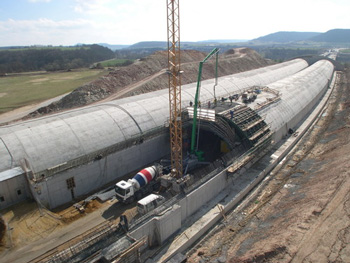
According to the order of construction, cut-and-cover system can be done in direct, inverse or door-to-door excavation methods.
Direct cut-and-cover consists on surface reestablishment after completing of all works.
Inverse method, however, considers the surface reestablishment just after completing the first-level slab of the underground structure.
The door frame method is similar to the inverse method, but instead of retaining walls, foundation elements are built.
More info:
- Surface tunneling ITA slideshow (Adobe Pdf 6mb)
Immersed tunnels have been in widespread use for about 100 years.
Over 150 have been constructed all over the world, about 100 of them for road or rail schemes. Others include water supply and electricity cable tunnels.
These tunnels are a very good solution everytime there is a main course of water that need to be traversed. Once completed, an immersed tunnel is no different operationally from any other tunnel. However, it is built in a completely different way.
Advantages and perceived problems
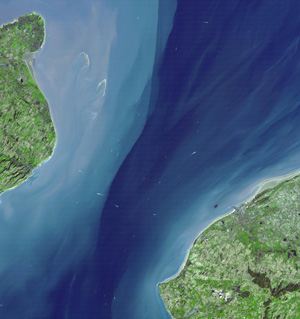
Whenever there is a need to cross water, an immersed tunnel should be considered. The final choice of crossing type will of course depend on many factors. The table below gives an indication of circumstances which favour immersed tunnelling.
- Immersed tunnels can be built shallow, permitting shorter tunnels and flatter alignments than bored tunnels.
- Immersed tunnel cross sections are highly versatile, making them particularly suitable for wide highways and combined road/railway crossings.
- Typically built in between 5m and 30m of water, although schemes have been postulated for 100m depth. Submerged floating tunnel technology (see next chapter) will make water depth immaterial.
- Most types of ground can be dealt with, including soft alluvial materials. Conditions unsuited to bored tunnelling do not usually pose a problem. Design for earthquake zones has shown to be perfectly feasible.
- Immersed tunnels are often prefabricated remote from the final immersion site, allowing installation in extremely congested (e.g. urban) locations where nearby land is not available.
- Dredging operations present an opportunity to reshape riverbanks and coastlines as part of a tunnel construction scheme. They are, for example, commonly associated with land reclamation schemes.
-
Immersed tunnels do not have to be circular in cross section. Almost any cross section can be accommodated, making immersed tunnels particularly attractive for wide highways and combined road/rail tunnels. Some examples of realised cross sections are shown below.

- Immersed tunnels can be placed immediately beneath a waterway. In contrast, a bored tunnel is usually only stable if its roof is at least its own diameter beneath the water. This allows immersed tunnel approaches to be shorter and/or approach gradients to be flatter - an advantage for all tunnels, but especially so for railways.
- Immersed tunnels can be constructed in ground conditions which would preclude bored tunnelling or render it prohibitively expensive, such as the soft alluvial deposits characteristic of large river estuaries. They can also be designed to deal with the forces and movements in earthquake conditions, to be placed in very soft ground in an area prone to significant earthquake activity.
- Bored tunnelling is a continuous process in which any problem in the boring operation threatens delay to the whole project. Immersed tunnelling creates three operations - dredging, tunnel element construction and tunnel installation, which can take place concurrently, thus moderating programme risk considerably. Partly for this reason, an immersed tunnel is generally faster to build than a corresponding bored tunnel.
Immersed tunnels are sometimes perceived by newcomers to the technology as "difficult" due to the presence of marine operations. In reality though, the technique is often less risky than bored tunnelling and construction can be better controlled. The marine operations, though unfamiliar to many, pose no particular difficulties. The perceived problems include:
- Dredging technology has improved considerably in recent years, and it is now possible to remove a wide variety of material underwater without adverse effects on the environment of the waterway.
- Interference with navigation: On busy waterways, it is sometimes assumed that construction of an immersed tunnel would be impractical as it would interfere with shipping. In fact, such tunnels have been successfully built in some exceptionally busy waterways without undue problems.
- It is often assumed that the process of building a tunnel in water, rather than boring through the ground beneath it will increase the likelihood of leakage. In fact, immersed tunnels are nearly always much drier than bored tunnels, due to the above-ground construction of the elements. Underwater joints depend on robust rubber seals which have proved effective in dozens of tunnels to date.
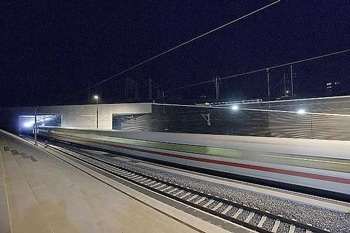
A typical example of underground structure where a combination of methods is employed is a deep base transalpine tunnel, like Gotthard and Lotschberg tunnels in Switzerland.
Some of the reasons that recommend such a method of excavation in these tunnels are a wide range of geological and hydro-geological conditions, the need of excavating complex security intermediate stations (caverns), the excavation of adit tunnels with great steepness, the complex logistical reasons and planning constraints, etc.
Very often, in the construction of very large underground structures, different methods of excavation are applied, combining both mechanized and conventional tunneling. This can be due to different reasons:
- Great differences in geological and hydrogeological conditions along the alignment of the underground structure might recommend the use of mechanized tunneling just where they suit the specific machines
- Logistical reasons: Advantage of reuse of the same TBM in different stretches of a tunnel, being this solution sometimes better than using another TBM at the same time
- Diversification of means to reduce the overall risk
- Conventional tunneling needed for the excavation of cavities and parts of the underground structure with complex geometry (e.g. a multifunctional station in the middle of a long rail tunnel)
- Possibility of using conventional tunneling during the time TBMs are assembled at the entry
- Conventional excavation used for the portals, where the ground tends to be meteorized and unstable
- Conventional excavation used to free TBMs when they get trapped due to difficult conditions
- Large underground structures where steepness and length of some of their parts do not allow mechanized excavation (e.g. adits or access tunnels to a main deep base tunnel)
For more info:
- Lyon-turin example layout of excavation (Adobe Pdf 6mb)



